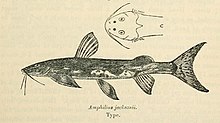Burbot catfish
| Burbot catfish | ||||||||||||
|---|---|---|---|---|---|---|---|---|---|---|---|---|

|
||||||||||||
| Systematics | ||||||||||||
|
||||||||||||
| Scientific name | ||||||||||||
| Amphiliidae | ||||||||||||
| Regan , 1911 |
The burbot catfish ( Amphiliidae) are a family of fish from the order of the catfish-like (Siluriformes). They are widespread in tropical Africa and are most common in fast-flowing waters at higher elevations.
features
Burbot catfish are small fish, usually less than 12 and a maximum of 19 centimeters in length. Their body is elongated with a pointed head and a slender, long tail stem. The animals have three pairs of barbels , the nasal pair is missing. The pectoral and pelvic fins are wide in many species and form a weak suction cup with which the animals can hold onto stones. The dorsal and anal fins have a short base. Hard rays are absent in all fins, except in the Trachyglanis and the Leptoglaninae, where the pectoral and dorsal fins have a weakly developed hard ray. A long, flat adipose fin is present and in some species has a modified scale that serves as a hard ray. The swim bladder has receded.
There are three subfamilies :
- The Amphiliinae have a relatively short body with a lower mouth . They never have bone plates or a neck shield.
- The Doumeinae have an elongated body with a lower mouth, which has a neck shield and often bone plates.
- In the Leptoglaninae, the maxilla is greatly elongated and, in contrast to most catfish, the radials close to the body are connected.
Systematics
The monophyly of the burbot catfish is doubted by some authors. These then arrange the Doumeinae and Leptoglaninae in a separate family Doumenidae. In the classical system, the burbot catfish are placed in the superfamily Loricarioidea. According to molecular biological studies, they belong to the "Big Africa" group within the subordination of the Siluroidei.
If the Doumeinae and Leptoglaninae are not subdivided, the family includes 12 genera with a total of 66 species .
Subfamily Amphiliinae
The burbot catfish of the subfamily Amphiliinae have relatively short bodies that are similar to those of the flat loaches (Balitoridae). The mouth is under, bone plates and a neck shield are missing.
- Genus Amphilius ( type genus )
- Amphilius atesuensis
- Amphilius baudoni
- Amphilius brevis
- Amphilius cryptobullatus
- Amphilius jacksonii
- Amphilius kakrimensis
- Amphilius kivuensis
- Amphilius lamani
- Amphilius lampei
- Amphilius laticaudatus
- Amphilius lentiginosus
- Amphilius longirostris
- Amphilius maesii
- Amphilius natalensis
- Amphilius opisthophthalmus
- Amphilius platychir
- Amphilius pulcher
- Amphilius rheophilus
- Amphilius uranoscopus
- Amphilius zairensis
- Genus Paramphilius
Subfamily Doumeinae
The burbot catfish of the subfamily Doumeinae have an exceptionally long maxillary . The fin supports facing the body are fused together.
- Genus Andersonia
- Genus Belonoglanis
- Genus Doumea
- Genus Phractura
- Genus Trachyglanis
Subfamily Leptoglaninae
The burbot catfish of the subfamily Leptoglaninae have elongated bodies. The mouth is below. The neck is protected by a bony shield. Bone plates are also often found along the trunk.
- Genus Dolichamphilius
- Genus Leptoglanis
- Genus Psammphiletria
- Genus Tetracamphilius
- Genus Zaireichthys
swell
- Joseph S. Nelson : Fishes of the world . 4th edition. John Wiley & Sons, Hoboken 2006, ISBN 978-0-471-25031-9 , pp. 164 .
- Tim M. Berra: Freshwater Fish Distribution . The University of Chicago Press, Chicago 2007, ISBN 978-0-226-04442-2 , pp. 216-217 .
Individual evidence
- ^ Günther Sterba : Freshwater fish from all over the world . Urania, Leipzig, Jena, Berlin 1977, pp. 237 .
- ^ Joseph S. Nelson: Fishes of the world . 4th edition. John Wiley & Sons, Hoboken 2006, ISBN 978-0-471-25031-9 , pp. 164 .
- ↑ JP Sullivan, Lundberg JG; Hardman M: A phylogenetic analysis of the major groups of catfishes (Teleostei: Siluriformes) using rag1 and rag2 nuclear gene sequences . In: Mol Phylogenet Evol. . 41, No. 3, 2006, pp. 636-62. doi : 10.1016 / j.ympev.2006.05.044 .
- ^ Entry of the family at ITIS



